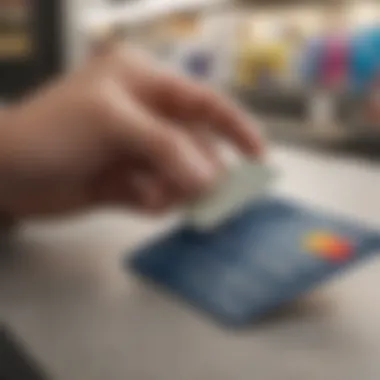Comprehensive Guide to Popular Prepaid Cards


Intro
In today's financial landscape, prepaid cards have emerged as a viable alternative to traditional banking products. These cards serve a variety of purposes and are appealing to diverse demographics. Understanding the intricacies of prepaid cards can empower consumers to make informed decisions about their financial tools. This article will present a thorough overview of prepaid cards, detailing their features, benefits, applications, and potential drawbacks.
Overview of Financial Product
Definition
Prepaid cards are payment cards that allow users to load money onto them before making purchases. Unlike credit cards, they do not offer a line of credit. Funds are deducted from the pre-loaded amount, enabling users to control their spending effectively.
Key Features
Some essential features of prepaid cards include:
- Reloadable: Users can add money multiple times.
- Accessible: They can be acquired without a bank account.
- Widely Accepted: Prepaid cards are recognized at many retail and online establishments.
- Safety: They can be used without revealing personal banking information.
Purpose and Benefits
Prepaid cards can serve multiple purposes, such as:
- Budgeting Tool: They help users manage expenses by limiting spending to available funds.
- Gift Card Alternative: They can be gifted without the complications of returns.
- Travel Expenses: Prepaid cards reduce the risk of carrying cash while traveling.
- Financial Empowerment: Ideal for individuals without traditional banking access.
Types and Categories
Prepaid cards can be classified into various categories based on their applications. Here are some common types:
- Retail Prepaid Cards: Offered by specific stores for use within their brand.
- General Purpose Reloadable Cards: Such as the Green Dot Card and NetSpend, usable nearly anywhere.
- Government Benefits Cards: Issued for the disbursement of government benefits.
- Payroll Prepaid Cards: Used by employers to pay employees without traditional checks.
Every type has its pros and cons. For example, retail cards may offer promotions but limit usability. General-purpose cards are versatile but may include fees for activation and reloading.
Application Process
Steps to Apply
To acquire a prepaid card, users generally follow these steps:
- Choose a Card: Research options that best fit needs.
- Visit Retailer or Online: Purchase at the store or order online.
- Register the Card: Some cards may require online registration.
Eligibility Requirements
Typically, prepaid cards have minimal requirements. No credit check is usually needed. However, users must be at least 18 years old in most cases.
Documentation Needed
While documentation needs vary, users may need to provide:
- Government-issued ID
- Social Security number (for registration)
Common Mistakes to Avoid
Some common pitfalls include:
- Not reading terms and conditions, leading to unexpected fees.
- Failing to protect card details, risking unauthorized use.
Tips for Success
To maximize benefits, consider:
- Choosing cards with lower fees.
- Regularly monitoring your balance to avoid overdraft fees.
Costs and Fees
Types of Fees Associated
Prepaid cards may come with several fees, including:
- Activation Fees: A one-time charge for card setup.
- Monthly Maintenance Fees: Charged for keeping the card active.
- Reload Fees: Costs incurred when adding funds.
- ATM Withdrawal Fees: Charges for withdrawing cash from ATMs.
Comparisons of Costs Across Options
Comparing the costs of different prepaid cards can help users select the best one. For example, some cards have no monthly fees if a certain balance is maintained, while others might have high reloading costs.
Understanding the various fees associated with prepaid cards can save you money and ensure that you choose a product that best fits your financial needs.
Intro to Prepaid Cards


Prepaid cards have emerged as a significant financial tool in today's economically driven society. They represent an alternative to traditional banking solutions, appealing to a diverse range of users including young professionals, families, and students. Understanding prepaid cards is essential as they offer unique benefits and limitations that can impact financial management.
Definition of Prepaid Cards
Prepaid cards are payment cards that are loaded with a specific amount of money before they can be used. They function similarly to debit and credit cards but do not require a bank account or credit approval. Users can only spend the amount that has been preloaded onto the card, making it easier to manage budgets and avoid overspending. These cards come in various forms, including reloadable options as well as single-use gift cards.
How Prepaid Cards Work
The mechanism of prepaid cards is relatively straightforward. Users purchase a card, then load it with funds either through cash, bank transfer, or electronic deposit. Once the funds are loaded, the card can be used to make purchases at retailers, online, or for services that accept card payments. Each transaction deducts the amount spent from the card’s balance.
It's important to note that some prepaid cards allow users to reload them, while others do not. Typically, a prepaid card has several functionalities, such as:
- In-store Purchases: Similar to a debit card, users can swipe their prepaid cards at physical stores.
- Online Transactions: Prepaid cards are often accepted by online retailers, allowing a cash-free shopping experience.
- Savings Options: Some prepaid cards provide tools for budgeting and savings, offering rewards or incentives for saving.
Prepaid cards are especially useful for individuals who wish to limit their spending or need a financial tool without the complications of traditional banking.
In summary, the importance of the introduction to prepaid cards lies in understanding their definition and operation, leading to informed decision-making regarding their use in personal finances.
Types of Prepaid Cards
Understanding the different types of prepaid cards is essential for consumers seeking effective financial tools. Each category serves specific needs and comes with distinct features. Knowing the variations can help individuals choose the right product tailored to their requirements. Prepaid cards can offer flexibility, security, and various benefits. However, consumers should also evaluate their unique financial situations before selecting the best type for their needs.
General-Purpose Reloadable Cards
General-purpose reloadable cards are among the most versatile options available. They function like debit cards and can be reloaded with funds multiple times. This allows users to manage their spending actively. These cards are widely accepted at most retailers, both online and offline, making them a practical choice for daily transactions.
Some advantages include:
- Budgeting: Users can set a specific budget and reload as needed, controlling their expenses.
- No Need for Bank Account: They allow access to electronic payments without a traditional bank account.
- Safety: These cards can be replaced if lost or stolen, offering peace of mind.
However, some fees might apply, such as activation fees or reloading fees. Thus, it’s critical for potential users to read terms and conditions carefully to tránh unnecessary charges.
Gift Cards
Gift cards have become a popular choice for gifting purposes, available for various retailers. They serve as a convenient way to give a specified amount to recipients. Unlike reloadable options, most are pre-loaded with a fixed amount and cannot be reloaded.
Key points include:
- Perfect for Gifting: They provide recipients with the freedom to choose items that they truly want.
- No Expiration for Many: Unlike traditional gift certificates, some gift cards do not expire.
- Brand Specific: They are typically limited to specific retailers, which can be a disadvantage if receivers prefer shopping elsewhere.
Before purchasing, one should be aware of any conditions attached, like fees for inactivity or potential expiration dates.
Travel Prepaid Cards
Travel prepaid cards are tailored for those planning trips, allowing easier currency exchange and money management overseas. These cards can usually be loaded with multiple currencies, making transactions while traveling more efficient.
Benefits include:
- Foreign Currency Options: Users can load different currencies to avoid conversion fees during travel.
- Safer than Cash: They reduce the risk of loss compared to carrying large amounts of cash.
- Trackable Spending: Many cards provide a way to monitor expenses through online portals.
Travel cards can charge foreign transaction fees, so evaluating the terms before purchasing is vital, especially for frequent travelers.
Virtual Prepaid Cards
Virtual prepaid cards are becoming increasingly popular, particularly for online transactions. These cards exist only in digital form, providing a unique card number, a security code, and expiration date. Users can purchase them through various platforms, making them a quick and secure way to shop online.
Advantages include:
- Instant Access: Users can access funds quickly without waiting for physical cards to arrive.
- Reduced Fraud Risk: As they are not linked to a bank account, they offer extra layers of security against fraud.
- Control over Online Spending: They allow users to limit their online transactions, minimizing risk exposure.
Overall, each type of prepaid card meets specific needs within the financial landscape. Conducting thorough research on the features can empower consumers to make informed decisions. This ensures they choose the product that aligns with their financial goals and lifestyle.
Benefits of Using Prepaid Cards
The significance of understanding the benefits of prepaid cards cannot be understated. These financial tools cater to a diverse audience, including young professionals, families, and students. By focusing on specific elements like financial control, reduced risk of debt, and ease of access, we can illuminate how prepaid cards serve as a valuable resource in managing everyday finances.
Financial Control and Budgeting
Prepaid cards offer users a tangible way to exercise financial control. Unlike credit cards, which can lead to overspending, prepaid cards limit expenditures to the available balance. This feature enables users to set a strict budget, ensuring they do not exceed their financial limits.
By preloading funds onto the card, individuals can allocate money for specific purposes, such as groceries or entertainment. This structured approach makes tracking expenses straightforward, making it easier to stay vigilant about one's financial health.
Reduced Risk of Debt
Another benefit of prepaid cards is lessening the risk of accruing debt. Since prepaid cards function based on the balance loaded by the user, there are no unexpected bills at the end of the month. For many, this feature is liberating. No need to deal with interest rates or credit scores. Individuals can avoid the pitfall of accumulating debt, which is particularly appealing to those who may struggle with self-discipline in spending.
"Prepaid cards empower users to spend wisely, protecting them from unmanageable debt."


Convenience and Accessibility
Prepaid cards provide a level of convenience that resonates with many consumers. They can be used wherever debit and credit cards are accepted, making them universally useful for both online and in-store purchases. Furthermore, obtaining a prepaid card is often simpler than getting a traditional bank account or credit card, which may require a good credit score or extensive documentation. This accessibility makes prepaid cards an attractive option for students and young professionals who may be new to managing their finances.
Overall, the combination of financial control, reduced risk of debt, and convenience, positions prepaid cards as a compelling solution for numerous financial scenarios. As users become increasingly aware of these benefits, prepaid cards can serve as an essential part of their financial toolkit.
Drawbacks of Prepaid Cards
Understanding the drawbacks associated with prepaid cards is crucial for consumers. While these cards offer various advantages, it is essential to consider their limitations as well. This section will discuss two primary drawbacks: fees and charges, and limited consumer protections.
Fees and Charges
One significant disadvantage of prepaid cards is the potential for high fees. Many prepaid cards impose various charges that can accumulate quickly. These can include initial purchase fees, monthly maintenance fees, and ATM withdrawal charges. Depending on the issuer, some prepaid cards may charge for service transactions, including balance inquiries or customer service calls.
It is essential to read the fine print when considering a prepaid card. Not all cards are created equal, and the fee structures can vary widely. Some may appear attractive initially but can become costly over time. Here are some typical fees that users might encounter:
- Loading Fees: Some cards charge a fee to load money onto the card, which can diminish the amount available for spending.
- Transaction Fees: Each purchase may incur a small charge, which erodes the card's value.
- ATM Withdrawal Fees: Using ATMs not within the card’s network can lead to substantial fees.
Understanding all applicable fees is important; sometimes, a card with a higher monthly fee may actually be less expensive overall than a card loaded with hidden charges.
Limited Consumer Protections
Another critical drawback is the limited consumer protections associated with prepaid cards. Unlike credit or debit cards, which typically have built-in protections regarding unauthorized transactions, prepaid cards may not offer the same level of security.
For example, if a prepaid card is lost or stolen, the cardholder might face challenges in recovering lost funds. Many prepaid card issuers limit the liability of unauthorized transactions but not all follow the same standards. Therefore, it becomes vital to understand the issuer's policies regarding fraud and loss recovery.
Moreover, prepaid cards often do not provide the same fraud protection mechanisms that credit cards offer. This limitation can make users vulnerable to fraud and identity theft.
In summary, while prepaid cards can be beneficial for financial management, it is vital to recognize their drawbacks. The combination of potentially high fees and limited consumer protections makes it essential for users to conduct thorough research before selecting a prepaid card.
Comparing Prepaid Cards to Other Financial Products
Understanding the nuances of various payment methods is essential for making informed financial decisions. This section compares prepaid cards with other financial products, specifically debit and credit cards. Prepaid cards offer distinct features and benefits that can be advantageous for certain demographics, such as young professionals, families, and students.
Prepaid Cards vs.
Debit Cards
When contrasting prepaid cards with debit cards, several key differences emerge. Prepaid cards function independently of a bank account. Users load money onto the card before making purchases. In contrast, debit cards are linked to an individual's checking account, allowing funds to be withdrawn directly. Here are some important factors to consider:
- Control Over Spending: Prepaid cards help users stick to a budget. They limit spending to the amount loaded onto them. Debit cards also allow for controlled spending, but overdraft protection may cause users to spend more than intended.
- Accessibility: Prepaid cards do not require a bank account, making them accessible for individuals without traditional banking services. This can include students or those with limited credit history.
- Fees: Both card types may have associated fees. Prepaid cards can have activation or monthly fees. Debit cards may incur overdraft fees. Understanding the fee structures of each card is important for making an informed choice.
"Prepaid cards serve as a financial tool that promotes better spending habits, especially for those learning to navigate personal finance."
Prepaid Cards vs.
Credit Cards
The difference between prepaid and credit cards is another vital comparison. Credit cards allow individuals to borrow money up to a certain limit, and interest can be charged on unpaid balances. On the other hand, prepaid cards restrict spending to the balance available on the card. Consideration should be given to the following:
- Debt Management: Users of prepaid cards are not at risk of accumulating debt since they can't spend more than what is loaded. Credit cards, while they offer benefits like rewards, can lead to high-interest debt if not managed responsibly.
- Building Credit: Credit cards have the potential to build credit scores when used wisely. Prepaid cards do not affect credit scores, which may be a downside for those looking to establish or improve their credit.
- Rewards Programs: Many credit cards offer rewards and cashback on purchases. Prepaid cards typically do not offer such benefits. This is a crucial consideration for frequent shoppers who want to make the most out of their spending.
Choosing the Right Prepaid Card
When it comes to prepaid cards, making the right choice can profoundly impact your financial management. The variety of options available can be overwhelming. Prepaid cards cater to different needs, making it essential to identify what best fits your lifestyle and goals. Understanding the unique features of various prepaid cards allows you to align them with your specific requirements.
Assessing Your Needs
Before selecting a prepaid card, assess your personal financial needs. Consider the primary purpose of the card. Are you looking for convenient daily spending, budgeting support, or a travel solution? Each card serves different functions.
Also, think about the amount you plan to load onto the card. Some cards have limitations on the loading and spending amounts. Understand your spending patterns. Ensure the chosen card will adequately support your habits.
Consider any special needs you might have, such as managing funds for children or reserving money for travel expenses. Evaluating these aspects is crucial to choose a prepaid card that reflects your financial behavior.
Comparing Features and Fees
The landscape of prepaid cards is diverse, and the features and fees can vary greatly. Start by comparing the key features of the cards.
Look for cards that offer the following:
- Reloadable Options: Some cards allow you to add funds regularly, which may be ideal for ongoing expenses.
- Rewards Programs: Certain cards provide cashback or other rewards on purchases, which can be advantageous.
- User-Friendly Apps: A good card should offer a robust mobile app for monitoring transactions easily.
In addition to features, pay close attention to fees. Different cards have various fee structures, including monthly maintenance fees, transaction fees, and ATM withdrawal fees. Understanding the total cost associated with each card can lead to substantial savings over time. Ultimately, a thorough comparison will empower you to make an informed decision that aligns with your financial objectives.
Key takeaway: Always assess personal needs and compare various aspects of prepaid cards. This will enhance your financial efficiency and reduce unnecessary costs.
Top Popular Prepaid Cards
Prepaid cards have become a significant financial tool in today's economy, offering an alternative to traditional banking products. Their flexibility and widespread acceptance make them appealing for various demographics, such as young professionals, families, and students. Understanding the leading options in prepaid cards is essential for consumers to make informed choices that suit their unique financial needs. In this section, we will explore the prominent prepaid cards available, their features, and aspects to consider when selecting a card that fits one’s lifestyle.


Overview of Leading Options
Several prepaid cards dominate the market, each catering to different needs. Some of the notable ones include:
- NetSpend Visa Prepaid Card: This card is well-known for its reloadable feature and widespread acceptance. It's particularly useful for budgeting as it allows users to load funds as per their requirements. With the option of direct deposit and a mobile app, it offers convenience.
- Green Dot Prepaid Mastercard: Green Dot provides a robust online banking experience. It also allows for bills payment directly, making it a favorite for those who prefer digital management. Users often appreciate its compatibility with various apps.
- PayPal Prepaid Mastercard: This card links directly to a PayPal account, giving users easy access to their online funds. It’s especially useful for individuals who frequently shop online or transfer money to friends and family. It often comes with rewards programs which can be attractive for frequent users.
- Bluebird by American Express: Aimed at families and those who want to avoid fees, Bluebird offers features like free ATM withdrawals in the Allpoint network. It combines the flexibility of a prepaid card with features traditionally associated with bank accounts.
Each of these cards has distinct advantages. When choosing a prepaid card, users should consider how they prefer to manage their money and which features are necessary for their situation.
User Reviews and Ratings
User reviews play a crucial role in understanding the practical aspects of prepaid cards. Feedback from real-life experiences can illuminate the benefits and drawbacks associated with each option.
- NetSpend Visa Prepaid Card: Users often praise its ease of use and the financial control it provides. However, some express concern over the fees associated with certain services, which can detract from its overall value.
- Green Dot Prepaid Mastercard: Many appreciate the digital features and convenience but note that customer service can sometimes be challenging to reach.
- PayPal Prepaid Mastercard: Reviewers frequently commend its integration with online payment systems. Yet, some users report delays in fund transfers during peak periods.
- Bluebird by American Express: This card generally garners positive feedback for its no-fee ATM withdrawals and user-friendly app. However, users occasionally mention limitations on certain transactions and in-store usability.
User ratings help to illustrate the overall experiences people have had with these prepaid cards. By integrating this feedback, consumers can better assess their options and find the prepaid card that best aligns with their financial habits and goals.
Using Prepaid Cards Internationally
Using prepaid cards internationally can offer significant advantages to travelers and those who conduct business across borders. This section discusses essential factors to consider when utilizing prepaid cards abroad. Whether for an extended trip or brief visits, understanding how these cards operate in various countries is crucial for efficient financial management.
Considerations for Global Use
When using prepaid cards on an international level, several factors must be examined. First, it is vital to ensure that the card is accepted in the desired locations. Not all prepaid cards have universal acceptance, especially in certain regions. Additionally, the cardholder must understand the currency exchange rates and policies that the issuing bank has in place. Some cards might offer favorable rates, while others can have hidden fees that can inflate costs unexpectedly.
Moreover, it is prudent to inquire about load limits and withdrawal capabilities in foreign nations. Certain cards allow for cash withdrawals; however, local ATM facilities might impose additional charges.
Another consideration is accessibility to customer service while overseas. If a cardholder experiences issues or needs emergency assistance, having a reliable customer service number to call is essential. Many prepaid cards provide 24/7 support, which can be invaluable during international travel.
In summary, when planning to use prepaid cards internationally, research the card's acceptance, currency exchange rates, load limits, and available support.
Foreign Transaction Fees
Foreign transaction fees are a significant aspect to consider when using prepaid cards abroad. These fees often vary depending on the card issuer and can impact the total cost of purchases made outside of the home country. Many prepaid cards charge a percentage of each transaction conducted in a currency other than the card’s domestic currency. This percentage generally ranges from 1% to 3%.
When evaluating prepaid cards for international use, it is advisable for consumers to look for cards with minimal or no foreign transaction fees. Such options are increasingly available; however, understanding the fine print before making a selection is essential. For instance, while a card may advertise no transaction fees, they might charge higher exchange rates, effectively offsetting any potential savings.
A careful assessment of how often one expects to use the card abroad can help determine which prepaid card aligns best with the intended travel plans. Here is a quick overview:
- Card A: 0% foreign transaction fee | Favorable exchange rates
- Card B: 2% foreign transaction fee | Average exchange rates
- Card C: 1% foreign transaction fee | No ATM withdrawal limit
Important: Always confirm the specific fees associated with your chosen card before travel to avoid unexpected costs.
Overall, being informed and assessing each card's features allows for prudent financial planning when using prepaid cards internationally.
Regulations and Security of Prepaid Cards
Understanding the regulations and security of prepaid cards is crucial for anyone considering their use. This section details the legal framework and security measures that protect consumers. These aspects give assurances about the reliability and safety of prepaid cards, which are essential for responsible use and help in mitigating risks associated with fraud and mismanagement.
Regulatory Environment
The regulatory environment surrounding prepaid cards is complex. In many countries, payments with prepaid cards are subject to laws designed to protect consumers. For instance, in the United States, the Consumer Financial Protection Bureau (CFPB) oversees many aspects of prepaid card use. This oversight includes requiring clear disclosures of fees and terms associated with the cards. These regulations ensure that consumers know any potential costs before using prepaid cards. Some key points regarding the regulations include:
- Disclosure requirements: Companies must provide consumers with clear information about fees, limits, and other important details.
- Consumer protections: In some jurisdictions, there are rules to prevent fraud, requiring issuers to protect funds lost due to unauthorized transactions.
- Compliance with anti-money laundering laws: Prepaid card companies must often monitor transactions for signs of illegal activity, helping to maintain the integrity of financial systems.
These regulatory frameworks contribute significantly to consumer confidence. When users know that their funds have protections, they are more likely to rely on prepaid cards for daily transactions.
Security Features
Security is an important aspect of prepaid cards that consumers must consider. Many prepaid cards come equipped with various features to enhance protection against fraud. Here are some notable security features:
- EMV Chip Technology: Many issuers now use EMV chips, which provide encryption for transactions, making it harder for fraudsters to duplicate cards.
- Two-Step Verification: Some cards offer an added layer of protection during online transactions, requiring a second form of identification or verification.
- Real-Time Notifications: Users can receive alerts for every purchase transaction, allowing them to quickly spot unauthorized charges.
- Locking and Unlocking: Many cards now allow users to lock or unlock their accounts via an app or website, providing immediate control if a card is lost or stolen.
These security measures are essential in today’s digital age, providing consumers with reassurance as they navigate financial transactions.
Culmination
The conclusion of this article serves as a crucial wrap-up of the extensive examination conducted about prepaid cards. It emphasizes the various aspects discussed throughout the sections, allowing readers to comprehend the importance of making informed decisions. Prepaid cards are tailored for a diverse audience including young professionals, families, and students. Their unique features create distinct financial benefits, which are vital in today's economy.
Summarization of Key Points
In this article, we explored several key elements regarding prepaid cards:
- Definition and Functionality: Prepaid cards allow users to load money upfront and spend it without incurring debt. This feature makes them effective for budget management.
- Types of Prepaid Cards: Different variants like general-purpose reloadable cards, gift cards, travel prepaid cards, and virtual prepaid cards fulfill specific needs and offer unique advantages.
- Benefits: Prepaid cards provide financial control, reduced debt risk, and convenience in transactions, especially for those who may struggle with traditional banking.
- Drawbacks: Potential fees and limited consumer protections are important considerations before choosing a prepaid card.
- Comparative Analysis: The relationship between prepaid cards, debit cards, and credit cards shows how they fit into the broader spectrum of financial products.
- Security and Regulation: Understanding the regulatory environment and security features helps users select a trusted prepaid card.
Final Recommendations
- Assess Individual Needs: Understand your spending habits and requirements before selecting a prepaid card. This ensures the choice aligns with your financial goals.
- Compare Fees and Features: Evaluate the costs associated with various prepaid cards. Some may have low fees but limited features, while others offer more services.
- Research Providers: Research different card issuers and their reputations. Look at user reviews on platforms like Reddit or Facebook, as they often provide firsthand feedback on experiences.
- Utilize Regulatory Resources: Familiarize yourself with the regulations that govern prepaid cards. Knowledge about your rights as a consumer is crucial for safe usage.
Choosing a prepaid card is not merely about convenience; it is about making a financial decision that best suits your lifestyle and spending habits.
Making a comprehensive evaluation of the discussed elements will aid in making a prudent choice regarding prepaid cards.



